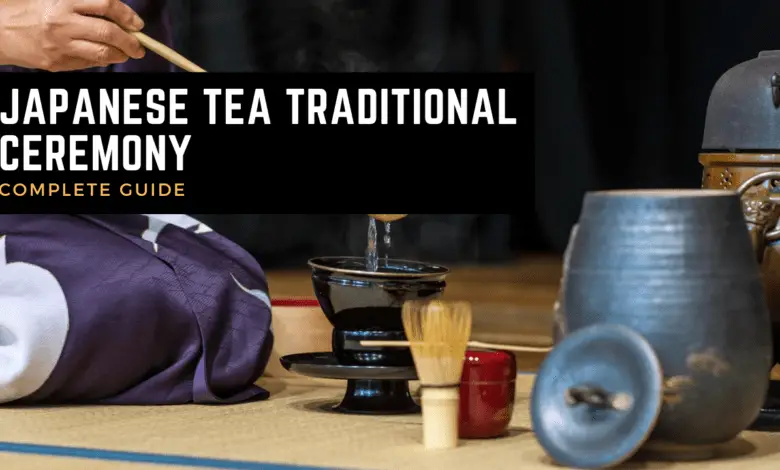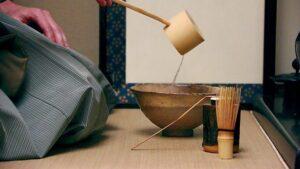Japanese Tea Traditional Ceremony: A Window into Japanese Culture
Explore the Art, History, and Rituals of Japan's Iconic Tea Ceremony

Introduction
The Japanese Tea Ceremony, known as “chanoyu” or “sado,” is a mesmerizing and deeply symbolic ritual that has been an integral part of Japanese culture for centuries. This unique and intricate practice goes beyond simply preparing and enjoying a cup of tea; it is a profound reflection of Japanese aesthetics, philosophy, and social customs.
In this blog post, we will delve into the world of the Traditional Japanese Tea Ceremony, exploring its rich history, key elements, and the cultural significance it holds for the Japanese people. Join us on a journey into the heart of Japanese culture, where every gesture, every utensil, and every sip of tea tells a story.
The Historical Roots of the Tea Ceremony
Origins in China and Development in Japan
The tea ceremony, also known as Chanoyu in Japan, has deep historical roots that trace back to ancient China before evolving into the revered cultural practice it is today in Japan. It all began in China during the Tang Dynasty (618-907 CE) when tea became an integral part of Chinese culture. Initially, tea was consumed for its medicinal properties and as a symbol of status among the aristocracy. However, it was during the Song Dynasty (960-1279 CE) that the art of brewing and serving tea became more refined.
Chinese tea culture greatly influenced Japan when Buddhist monks and Chinese emissaries introduced tea to Japan in the 8th century. The Japanese adapted and refined the tea ceremony, incorporating their own unique cultural elements. The tea ceremony, in its Japanese form, was refined over the centuries, particularly during the Muromachi period (1336-1573 CE) when it gained prominence. It was during this time that Sen no Rikyū, a revered tea master, played a pivotal role in shaping the ceremony into its current state.
Influence of Zen Buddhism
One of the most significant factors in the development of the Japanese tea ceremony was the influence of Zen Buddhism. Zen teachings emphasized mindfulness, simplicity, and the appreciation of the present moment, all of which are integral to the tea ceremony.
Zen Buddhism’s influence can be seen in various aspects of Chanoyu. The emphasis on mindfulness is reflected in the deliberate and precise movements of the tea ceremony, where every action, from boiling water to serving tea, is done with utmost focus and attention. The tea room itself is designed to create an atmosphere of tranquility and meditation, with minimal decoration and natural elements like bamboo and wood.
Additionally, the concept of “Wabi-sabi,” which is deeply rooted in Zen philosophy, is an essential element of the tea ceremony. Wabi-sabi celebrates imperfection and the beauty of the transient and imperfect nature of life. This is evident in the rustic and simple aesthetics of the tea utensils and the humble surroundings of the tea room.
Key Elements of the Tea Ceremony
The Tea Room (Chashitsu)
The tea room, known as the “chashitsu” in Japanese, is a sacred space where the tea ceremony takes place. It is designed with careful consideration of aesthetics and functionality. Key elements of the tea room include:
- Tatami Flooring: The floor of the chashitsu is covered with tatami mats, which not only provide a comfortable seating area but also set the stage for the guests to sit in a specific arrangement.
- Tokonoma: The tokonoma is a built-in alcove in the tea room where a scroll or seasonal flower arrangement (ikebana) is displayed. It serves as a focal point of aesthetic appreciation.
- Shoji Screens: The chashitsu typically has sliding shoji screens made of paper and wood. These screens allow for the control of natural light and create an atmosphere of tranquility.
- Higashiguchi and Shokyaku: The entrance to the tea room is a small, humble door called “higashiguchi,” and guests enter on their knees through this door. The “shokyaku” is a low, small door that symbolizes humility and respect.
The Tea Utensils (Chadōgu)
The tea utensils, or “chadōgu,” are essential tools used in the tea ceremony. They are carefully selected and prepared for each ceremony. Key utensils include:
- Chawan: The tea bowl, known as the “chawan,” is where the matcha (green tea) is prepared and served. Each chawan is unique and may vary in size, shape, and design.
- Chasen: The bamboo tea whisk, or “chasen,” is used to froth the matcha powder with hot water. It is an essential tool for achieving the right consistency and flavor.
- Chashaku: The tea scoop, or “chashaku,” is a small bamboo utensil used to measure the appropriate amount of matcha powder. It is carved from a single piece of bamboo and is a symbol of precision.
- Kensui: The waste-water container, or “kensui,” is used to dispose of any excess water or tea during the ceremony discreetly. It is emptied with great care.
The Tea Preparation (Temae)
The tea preparation, known as “temae,” is a meticulously choreographed process of making and serving matcha. It includes specific steps such as the purification of utensils, the whisking of matcha, and the presentation of the tea to guests. Temae is a combination of precise movements and mindfulness, ensuring that each cup of matcha is prepared with utmost care and respect. That’s why Japanese tea is popular these days.
The Role of the Host and Guest
In the tea ceremony, there are distinct roles for the host (usually the person conducting the ceremony) and the guest (the recipient of the tea). The roles emphasize mutual respect and harmony:
- Host (Chaji or Chakai): The host is responsible for preparing and serving the tea. They create a welcoming and peaceful atmosphere in the tea room and ensure that the guests are comfortable.
- Guest (Chajin): The guest participates in the ceremony with gratitude and humility. They follow specific etiquette, such as bowing, receiving and drinking the tea, and showing appreciation for the host’s efforts.
The interaction between the host and guest is characterized by a sense of harmony, respect, and mindfulness, making the tea ceremony not only a beverage preparation but also a profound social and cultural experience.

The Ritual and Symbolism
The Choreography of the Ceremony
The tea ceremony, often referred to as Chanoyu in Japan, is a highly choreographed and ritualistic practice. The choreography involves a series of precise and deliberate movements that unfold in a specific order, creating a sense of harmony and mindfulness. Key elements of the choreography include:
- Seating Arrangement: Guests are seated in a predetermined arrangement, typically in a U-shape or a straight line, facing the tokonoma (alcove) in the tea room. The host sits facing the guests, and this arrangement fosters interaction and connection.
- Purification Ritual: Before the tea is prepared, there is a purification ritual called “temae.” This involves cleansing and purifying the utensils, symbolizing the removal of impurities and distractions to create a pure and focused atmosphere.
- Preparing and Serving the Tea: The host prepares and serves the matcha (green tea) to the guests. The precise movements involved in scooping, whisking, and presenting the tea are designed to evoke mindfulness and respect for the process.
- Silent Communication: Much of the communication during the ceremony is non-verbal. Guests express appreciation through bows, gestures, and the way they receive and drink the tea. Silence is often observed to encourage contemplation and appreciation of the moment.
- Closing the Ceremony: The tea ceremony concludes with a closing gesture, typically involving the cleaning and careful placement of utensils. Guests express gratitude to the host, and the host reciprocates with humility.
The Symbolism of the Tea
Tea in the ceremony is rich in symbolism, reflecting both Japanese culture and the principles of Zen Buddhism. Some of the symbolic aspects of tea in Chanoyu include:
- Harmony: The act of sharing tea promotes harmony and a sense of togetherness among participants. The tea itself, when prepared correctly, represents harmony in its balance of bitter and sweet flavors.
- Respect: The careful handling of utensils, the bowing, and the etiquette throughout the ceremony symbolize deep respect for each other and for the art of tea.
- Purity: The purification rituals and the focus on cleanliness symbolize the pursuit of purity in both the physical and spiritual sense.
- Transience: The beauty of the tea ceremony lies in its transience. The ephemeral nature of the experience reminds participants of the impermanence of life and encourages them to appreciate each moment fully.
The Spiritual and Philosophical Aspects
The tea ceremony is imbued with spiritual and philosophical elements, often influenced by Zen Buddhism:
- Mindfulness: The tea ceremony emphasizes being fully present in the moment, which aligns with Zen’s principle of mindfulness. Every movement and action is done with complete attention.
- Simplicity: The minimalist aesthetics of the tea room and the utensils reflect the Zen value of simplicity. This simplicity encourages participants to find beauty in the ordinary.
- Transcendence: Through the practice of Chanoyu, participants aim to transcend the mundane and connect with something greater. It offers a spiritual experience that goes beyond the act of drinking tea.
- Humility: Both the host and guest exhibit humility during the ceremony. This humility is a core tenet of Zen Buddhism, reminding participants of the importance of modesty and self-awareness.
Check out more details on Wikipedia about Japanese Traditional tea ceremony.
The Role of Japanese Tea in Society
The Tea Ceremony as a Social Practice
In Japanese society, the tea ceremony, known as Chanoyu or Sadō (the Way of Tea), plays a significant role as a social practice that extends far beyond the mere consumption of tea. It has deep cultural, social, and philosophical significance:
- Cultural Significance: The tea ceremony is a cultural treasure that reflects Japan’s history, aesthetics, and traditions. It is a symbol of Japanese refinement and sophistication.
- Social Bonding: Chanoyu serves as a means of social bonding and interaction. When people gather to participate in a tea ceremony, it provides an opportunity for meaningful connections and conversations.
- Expression of Hospitality: Hosting a tea ceremony is a gesture of hospitality and respect. Guests are welcomed into the tea room with utmost courtesy, and the host’s actions are aimed at ensuring the comfort and enjoyment of the guests.
- Education and Mentorship: The practice of Chanoyu often involves a mentor-student relationship. Novices learn from experienced tea masters, passing down not only the techniques but also the cultural and philosophical aspects of the tradition.
- Fostering Mindfulness: The tea ceremony encourages mindfulness and a focus on the present moment. Participants are encouraged to leave distractions behind and appreciate the beauty of the simple act of preparing and savoring tea.
Modern Adaptations and Variations
While the traditional tea ceremony remains a cherished cultural practice in Japan, there have been modern adaptations and variations to accommodate contemporary lifestyles and preferences:
- Casual Tea Gatherings: In addition to formal tea ceremonies, casual tea gatherings have become popular. These are less structured and allow for a more relaxed and accessible experience for participants.
- Tea Cafés and Modern Teahouses: Tea cafés and modern teahouses have emerged, offering a blend of traditional and contemporary elements. These establishments serve a wide range of teas, including matcha lattes and flavored teas, to cater to diverse tastes.
- Tea and Wellness: There is a growing interest in the health benefits of tea, leading to the emergence of wellness-oriented tea practices. Tea is now associated with relaxation, stress reduction, and overall well-being.
- Cultural Exchange: The practice of tea has transcended national borders, with tea enthusiasts around the world participating in tea ceremonies and appreciating Japanese tea culture.
- Tea in the Arts: Tea has also found its way into various forms of art, such as tea-inspired pottery and literature. Artists draw inspiration from the aesthetics and philosophy of tea.
FAQs
- What is the history behind the Traditional Japanese Tea Ceremony?
The Traditional Japanese Tea Ceremony dates back to the 9th century when tea was introduced to Japan by Buddhist monks. It evolved from a medicinal beverage into a cultural phenomenon.
- What is the significance of “wabi-sabi” in the tea ceremony?
“Wabi-sabi” is a central concept in the tea ceremony, celebrating imperfection and simplicity. It is reflected in the design of the tea room and the overall atmosphere.
- Who is the key figure in the tea ceremony?
The tea master, known as the “chajin,” plays a pivotal role in the ceremony. They undergo rigorous training to perfect the art of tea preparation.
- What is matcha, and how is it prepared?
Matcha is a powdered green tea used in the ceremony. It is prepared by whisking it with hot water to create a frothy, vibrant green tea.
- How does the tea ceremony promote mindfulness?
The tea ceremony encourages mindfulness through its deliberate and graceful movements. It provides a space for guests to be fully present in the moment.
- What role does the tea ceremony play in Japanese society?
The tea ceremony fosters connections, promotes spiritual enlightenment, and helps preserve Japan’s cultural traditions.
Conclusion
The Traditional Japanese Tea Ceremony is not just a ritual; it is a profound expression of Japan’s cultural identity. It invites us to slow down, appreciate simplicity, and find beauty in every moment. This centuries-old practice embodies harmony, respect, purity, and tranquility, which are core values in Japanese society.
As we conclude our exploration into this captivating world, we are reminded that the Tea Ceremony is more than a mere window into Japanese culture; it is a doorway to a deeper understanding of the Japanese way of life.
In a rapidly changing world, where the pace of life can be relentless, the Japanese Tea Ceremony stands as a testament to the enduring importance of tradition and mindfulness. It reminds us to cherish the present, honor our connections with others, and seek moments of tranquility in our busy lives.
So, the next time you sip a cup of tea, take a moment to reflect on the profound wisdom that the Japanese Tea Ceremony imparts and consider how it can enrich your own life, bringing a touch of serenity and cultural appreciation to each and every cup.
Up Next
Rich History of Rome: A Cultural Journey Through the Eternal City





Facebook Comments